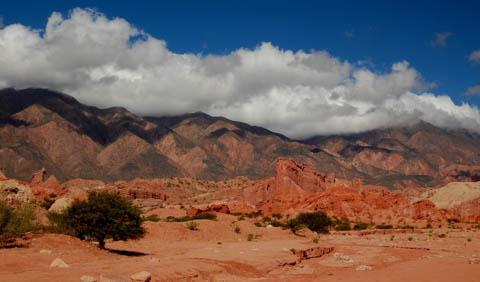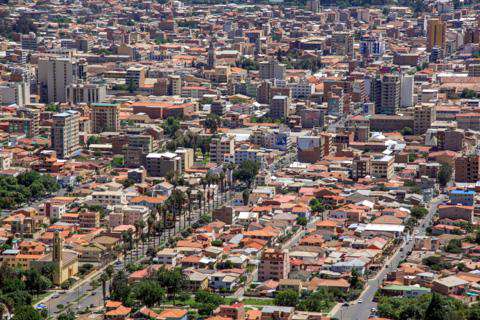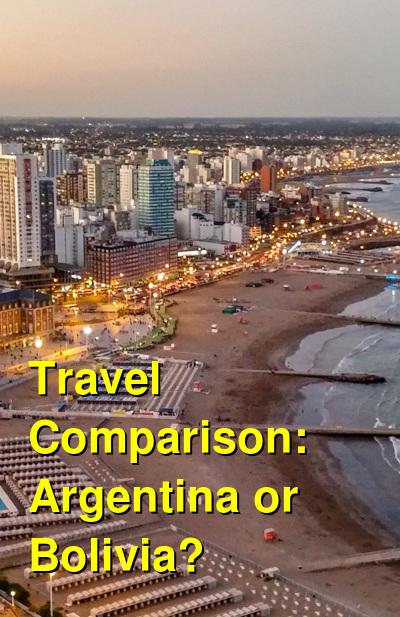Should you visit Argentina or Bolivia?
The top three destinations in Argentina are even more diverse as they include the romantic capital of Buenos Aires, the majestic Iguazu Falls on the border with Brazil and Los Glaciares National Park in Patagonia for the colossal Perito Moreno. In terms of spectacular scenery, Argentina perhaps has the edge here, being home to the Iguazu Falls, one of the world's most spectacular waterfalls and the Perito Moreno, one of the nation's top tourist attractions and a truly humbling sight. Argentina is perhaps a better destination for wildlife lovers, being home to one of the most celebrated spots. The Peninsula Valdes on coastal Patagonia provides habitats for a great variety of amazing creatures; a truly magical sight. Whales, elephant seals, sea lions and let's not forget the Punta Tombo Reserve, where the world's biggest colony of penguins resides.
The reasons to visit Bolivia are also abundant. While it's true that much of Bolivia isn't set up for tourism, those willing to go on this less traveled adventure are rewarded with eye-opening experiences, breathtaking activities, and stunning photo opportunities, not to mention fabulous stories to tell back home. On thing Uruguay and Bolivia have in common is that friendliness in both countries is reciprocal. Despite the widespread poverty in Bolivia, there is a amazing energy from locals eager to share the beauty of their country. In Uruguay and Bolivia, gracious hospitality and warm smiles are given to tourists who show respect, consideration and a genuine interest toward the local way of life. Contrary to what you may have heard, Bolivian food does not only consist in rice and beans but include meat, corn, eggs, potatoes and the "superfood" quinoa, one of the most commonly used ingredients in Bolivian cooking. Traditional dishes come from a mixture of Spanish cuisine and indigenous ingredients and include a lot of spice.
On the contrary to Uruguay, Bolivia is a country of extremes. From freezing cold snowy mountain peaks to sweltering hot amazon lowlands, the country has a great array of climates and cultures, attractions and adventures. With its high altitude cities and glistening lakeside villages, Bolivia's landscapes are incredibly diverse. From spectacular dusty red mountains and beautiful lakes to the dense Amazon jungle or the stunning Salar de Uyuni, Bolivia's transcendent scenery is breathtaking at every turn. This makes Bolivia one of the most bio-diverse countries on the planet and has about thousands of species of birds, animals, fish, reptiles and amphibians, which travelers can encounter during their trip if they pay attention. Bolivia is also a budget traveler's paradise that offers the best value for money in South America. You can eat well, sleep comfortably, purchase souvenirs and experience many of the activities and tours on offer without having to worry about money. Steeped in history and with indigenous culture everywhere, Bolivia will not disappoint you. The country's ability to combine a modern lifestyle with traditional values is truly wonderful. Ancient Andean customs are still practiced by many indigenous Bolivians who wear traditional dress and use natural remedies to treat illnesses. Catching a glimpse of the 36 indigenous cultures present in Bolivia, each with their own customs and most with their own languages, really makes an impression.. Finally, from the spiritual and traditional, to the more wild and westernized, Bolivia's festivals are unique, colorful and fun. If you can, travel to Bolivia during the Oruro Carnaval, a fantastic experience for any fun loving traveler.
Which country is cheaper, Bolivia or Argentina?
Should I visit Argentina or Bolivia? This is a popular question for many travelers. By figuring out which country is more expensive, you'll understand where you'll get more bang for your buck. A week in Bolivia can cost you about $442 (per person), while a week in Argentina may cost you around $463. These differences become even more noticable if you plan to spend a longer time in the country. 10 days, two weeks, or even one month of travel to Bolivia or Argentina can really add to your travel budget.
Accommodation is often cheaper in Bolivia compared to Argentina ($16 vs. $44). Budget travelers usually stay in less expensive hostels and guest houses, while nicer hotels often appeal to families and upscale travelers.
Compare hotel prices here: Argentina Hotel Prices and Bolivia Hotel Prices.
Or, compare hostel and guesthouse prices between Bolivia and Argentina to find the cheapest accommodation here: Bolivia hostels and Argentina hostels.
When comparing food in Argentina vs. Bolivia they are not just different in cuisine, but also in price. Meal and restaurant costs in Argentina ($5.89) are often cheaper than Bolivia ($27).
When is the best time to visit Argentina and Bolivia?
 Salta, Argentina
Salta, Argentina
If you are planning to hike through Patagonia and visit the natural wonders, then prioritize mid-seasons. Either go around September to November or from March to May. Both are low seasons, but the spring landscape, September to November, is the nicest of the two. If you do not handle the cold very well, avoid going to Patagonia before mid-October and after April. On the other hand if you love the snow, winter landscapes, skiing and travelling during low season with few tourists and lower prices, you should definitely visit Patagonia during end of autumn or beginning of spring. While you will get all the advantages of travelling during low season, you will also be able to enjoy a sunny weather, still quite cold but manageable. While a few activities (hikes, excursions) will begin to close (end of autumn) or still be closed (towards spring), you will definitely be able to do most of the essential activities and to fully enjoy some of them as you might find that you have a hiking path all to yourself! The differences in prices between low and high season are not tremendous but you will probably be able to save some money on deals with accommodation and a few other fees.
Consisting of temperate valleys, semi-arid highlands, humid jungles and balmy villages, Bolivia's weather differs greatly depending on the altitude and topography of the region. Because most of the country is situated at a high elevation, temperatures vary from hot and humid during the day to freezing cold at night. Although Bolivia is a country of climatic extremes, it is a destination that can be visited all year-round. Bolivia's temperatures are determined by the altitude as well as the season, with highland areas such as La Paz, Lake Titicaca, Potosi and Uyuni generally cool year round, extremely cold at night and with strong sunshine in the dry season, making high factor sunscreen essential. The ideal time to visit Bolivia depends on the sights you want to see, the tours you would like to experience, and the mode of transport you intend to travel. The eastern lowlands, including Santa Cruz and the Amazon, enjoy warm temperatures year round. The best time to visit the highland areas is from April to October, with June to September being the peak time for visitors, meaning that you should plan well in advance to get the best choice of accommodation. While it is the cooler winter period, it should be dry with plenty of sunshine. Bolivia's dry season is the most popular time of the year to travel, as road travel is easier and the bright sunny conditions mean you can photograph the salt flats and Lake Titicaca against dazzling blue skies. For those wanting to experience the "largest mirror on earth", visiting Salar de Uyuni between March and April will increase your chances of seeing the natural phenomena. Visiting Bolivia in November to March is still perfectly enjoyable for the more adventurous who don't mind occasional delays as roads can be disrupted due to heavy rains. The lower visitor numbers are also a bonus of visiting Bolivia at this time. As the rain season begins, temperatures become a little milder in the highlands and more humid in the lowlands.
Why is Argentina more expensive than Bolivia?
The last decade in Argentina has seen prices and currency exchange rates fluctuate greatly. Because of this, travel prices have generally risen as the overall economy is growing but economic uncertainty remains. It is best to plan ahead, do research into all options for accommodation, tours, and meals, and have a good understanding of the prices that lay ahead for your trip. But keep in mind that when travelling in Argentina, it's easy to be laid back about buying transportation tickets on the day of travel and it often makes no difference at all to do so, as prices are held steady usually by the overall price of fuel.
Bolivia is the ultimate cheap destination of South America. Although the country's recent economic progress has seen some prices and the standard of living rise, there are still bargains to be found in food and accommodation. Bolivia tends to offer the lowest prices for accommodation and the cheapest options for food and drink as well. There are certain tourist activities that you will need to take into account. For example, a popular activity is to ride a mountain bike down the so-called 'Death Road' near La Paz, which costs around USD$100 depending on the company and the quality of the bikes. A 3 day tour of the Salt Flats of Uyuni roughly costs $120, which is a steal for the incredible experience you will get.
What are the most expensive and cheapest cities and regions in Argentina and Bolivia?
 Cochabamba, Bolivia
Cochabamba, Bolivia
Buenos Aires, in Argentina, is one of the world's most recognizable tourist destinations. It's the birthplace of the tango, has stunningly preserved colonial architecture, a buzzing nightlife scene, and one of the world's trendiest neighborhoods. Buenos Aires but also other northern large cities such as Cordoba, Rosario and Mendoza are known to be rather expensive cities in Latin America. If you decide to visit the wine region, you can buy your own groceries and do your own bike tours in Mendoza to save a considerable amount of money but consider Mendoza as one of your splurge cities.
Southern Patagonia tends to be cheaper than the North. However, travelling through this large piece of land requires a certain budget and certain cities are surprisingly expensive. In the small towns of Patagonia, costs tend to be cheap due to competition. However, sometimes transportation can get pricey and the more frequently visited a destination by tourists, the higher the prices can get. The time of year and festivals can also dramatically affect cost.
Bolivia has long been a favorite among backpackers and adventure travellers due to the simple fact that it is very affordable to travel. If you are seeking comfort, although it might not be up to "Western" standards, it is available but if you are looking to save your pennies, this may be the best place in South America. There is not much difference in prices when travelling around Bolivia. Large cities such as Sucre, Copacabana and La Paz are perhaps a little more expensive than smaller towns due to competition and increasing tourism but accommodation and food remains so cheap that it is barely noticeable. Sucre is possibly the most beautiful city in Bolivia, full of proud inhabitants, cultural expressions and colonial architecture. Copacabana is mainly a base city from where you go explore Isla del Sol at Titicaca lake. You can also find cheap places to stay. If you are in a group, you can usually get a good discount if you all stay at the same hostel. La Paz is certainly one of the most unique cities in the world, a spectacular mix of chaos and beauty. La Paz is the highest capital in the world, and it is the true face of Bolivia.
How you can save money when visiting Argentina and Bolivia?
Don't fly domestically, as a two-hour flight can cost a lot. Unless you are in a rush, consider taking long distance buses.
In Bolivia, the surest way to waste money is to use credit cards. First of all, you will pay an extra 3% to use them anywhere you go. Secondly, many places don't accept them.
In supermarkets and stores that have price tickets on their items you cannot bargain the price down. But in most open markets it's a mistake not to. Vendors automatically increase the price as soon as they see you are foreign and expect your first reaction to be a request for a price break. Hold your line, stand firm, and be prepared to walk away if you don't like the price. After that, you'll be surprised at how prices will come down just a few seconds later.
Ask the locals what is great to see. Stay on the tourist path 100% of the time and you will waste a lot of money as well as miss out on some really nice places to visit. Most museums and art galleries in Bolivia don't charge an entry fee. Check out the hundreds of great local parks and plazas that provide amazing photo opportunities.
Be careful of fake taxis and other scams, especially in big cities like La Paz. Be particularly attentive to shared taxi, which are cheaper, but extremely dangerous as the driver can pick up other passengers without your permission.
Research what documentation is needed to enter the country. Americans need a tourist visa to enter Bolivia along with a yellow fever card and several other documents. Tourists from other countries have different requirements but all are required something to enter. Having all the correct documents before you arrive will be a true blessing to your wallet. Getting them here can cost you more, waste your time, and potential end up getting you sent home if you don't have the documentation you need.


 Budget Your Trip is all about finding out how much everything costs so that you can travel cheaper and longer. Created by avid travelers Laurie and Bryan, our goal is to help you plan your next trip on the right budget. With average daily travel costs that are calculated from the budgets of real travelers, plus an analysis of hotel and tour prices, you can find out how much money you need to plan your next adventure. We also have plenty of travel advice, accommodation reviews, and activity suggestions.
Budget Your Trip is all about finding out how much everything costs so that you can travel cheaper and longer. Created by avid travelers Laurie and Bryan, our goal is to help you plan your next trip on the right budget. With average daily travel costs that are calculated from the budgets of real travelers, plus an analysis of hotel and tour prices, you can find out how much money you need to plan your next adventure. We also have plenty of travel advice, accommodation reviews, and activity suggestions.
